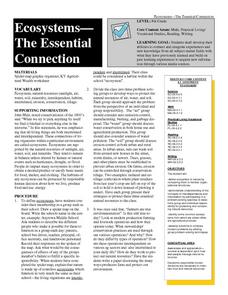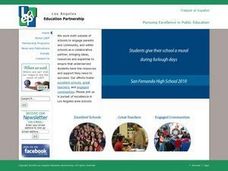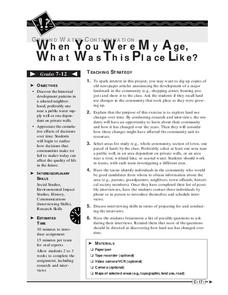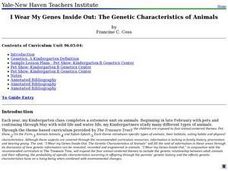Read Works
We Need Freshwater
Why do we need freshwater? Because freshwater sustains life. After reading a three-paragraph passage about the importance of freshwater, first graders respond to the article by answering comprehension questions. The resource includes...
Curated OER
A Potting We Will Go
Young scholars read A Tree is Nice and It Could Still Be a Tree. In this tree planting instructional activity, students compare and contrast private property and common resources. Young scholars identify the needs of a tree and follow...
Curated OER
Ecosystems-The Essential Connection
Students develop their abilities to solve problems both in school and in a variety of situations similar to that they have encountered in life. They define the term ecosystem in nature by comparing them to familiar organizational...
American Museum of Natural History
The Ancient City of Petra
Anyone who has seen Indiana Jones and the Last Crusade will recognize the entrance to the Nabataean city of Petra. Young archaeologists don't need horses or camels to travel through the Sig and tour this fascinating city, however. With...
Curated OER
The Middle-East; Water and Life
Tenth graders examine the physical and cultural impressions made by water in the Middle East, as well as their own lives, through exercises in reading, writing, geography and art. They explore how water as an economic good drives...
Curated OER
When You Were My Age, What Was This Place Like?
Students discover how land use in their community has changed. In this community and ecology lesson, students scan old newspapers to find articles about the development of community land. Students discuss and predict how land use has...
Curated OER
State or Region Project
Invite your youngsters to learn about a state or region through their choice of a creative project. The resource lists 15 project options that range from a 3-D map of the area, to a puppet show about the region. Pupils can also propose...
Curated OER
The Goat in the Rug
Students identify producers, resources and goods. In this economics lesson, students read the book The Goat in the Rug and define producers, resources, and intermediate goods. Students construct a rug which depicts the story of rug...
Curated OER
Who Lives Here?
Students explore the concept of philanthropy. In this environmental stewardship instructional activity, students examine water conservation efforts in desert regions as they act as members of a city council committee investigating the...
Curated OER
The Goat in the Rug
Students write a personal narrative about something they produce at home. (examples: make a sandwich, clean room, set table, do homework). Students should remember to mention different types of resources and intermediate goods used.
Curated OER
Is Your Classroom Ready for a Natural Disaster?
Emergency supplies and a well-developed plan will benefit your class during an unforeseen event.
Curated OER
Winter Holiday Activities Extravaganza
Students define culture and explore elements that are part of the custom or culture of a place. In this holiday lesson plan, students identify the cultures they participate in. Students identify the differences in people's...
Curated OER
World Continents
Students identify the continents of the world. In groups, students create a three-dimensional clay representation of their assigned continent. Using KidPix software, they draw and color their continent. Students research their continent...
Curated OER
The Electric Hearth
Students examine popular media. In this media awareness lesson plan, students keep logs of their interactions with media and then write an essay regarding the data.
Curated OER
Wants Vs. Needs: The Pilgrims sail to America
Young scholars work in groups to create a list of the items needed by the Pilgrims to bring to America. For this wants vs. needs lesson, students must agree on what should be on the list. Young scholars create their list by order...
Curated OER
The Family: Louisiana Family Folklore
Students determine that all families create and pass on folklore. They research stories of their own names and draw parallels between their own and others' naming traditions. They infer characteristics of their communities' history...
Curated OER
Which Way Is North?
Students investigate the concept of finding locations with the use of a compass and a map. They practice the skill of bearing and set up courses of travel to different destinations around the school grounds. Students also practice taking...
Curated OER
Designing a Study
Students explore features to consider when designing a scientific study. In this science research lesson plan, students examine different methods of data collection and consider which method would be appropriate for determining how many...
Curated OER
Taking Care of Business
Students participate in a service project. In this stewardship instructional activity, students review the concepts of philanthropy and environmental stewardship. Students practice being good stewards by researching public areas in their...
Curated OER
Creeping and Crawling Observing Mealworms and Earthworms
Fifth graders observe mealworms and earthworms. In this mealworm and earthworm instructional activity, 5th graders complete an experiment in which they observe the life cycle and living conditions of mealworms and earthworms. They...
Curated OER
I Wear My Genes Inside Out: The Genetic Characteristics of Animals
Young scholars create mixed breed dogs using paper illustrations of various breeds. They label dogs created by students using the Genetics Center and discuss the aspects of genetics that affect the outcome of the various projects.
Curated OER
Introducing Working Animals
Students identify ways humans and animals work together. In this animal welfare lesson, students read the text Hanni and Beth: Safe and Sound and define the term "working animals." Students investigate working animals by visiting various...
Curated OER
American History Through Architectural Masterpieces: Monticello
Young scholars examine the life of Thomas Jefferson, explore great American landmark Monticello, discover relationships between climate, geographical factors, and time as to what kind of architecture was used, conduct research online,...























